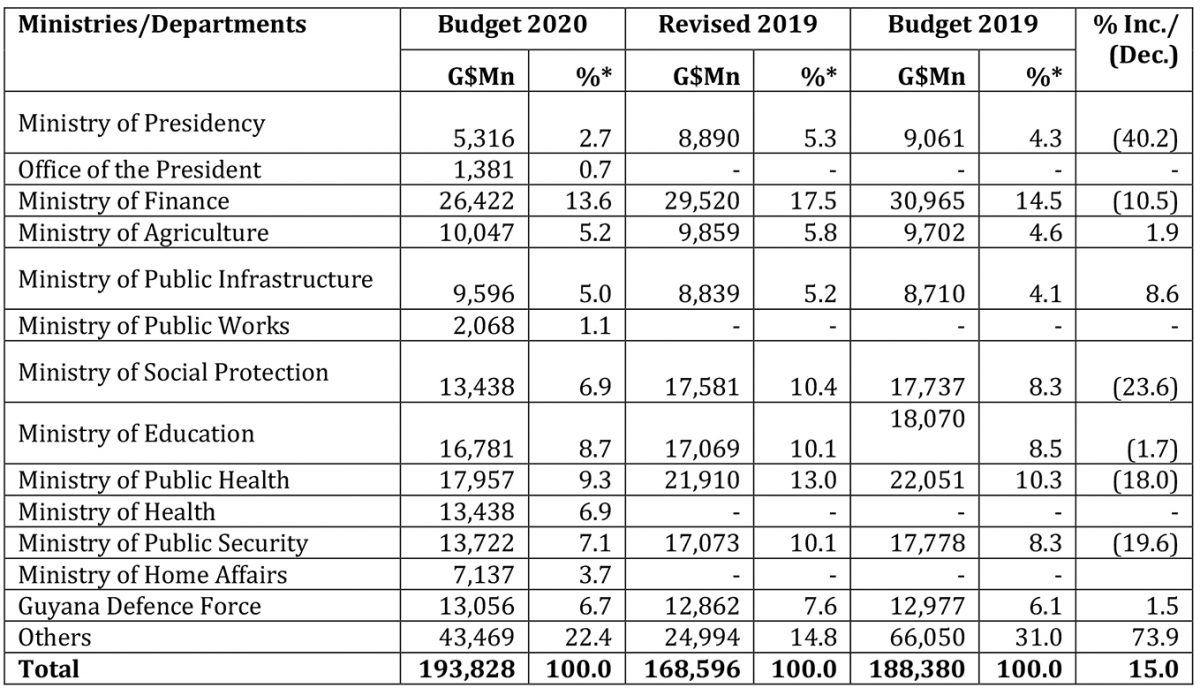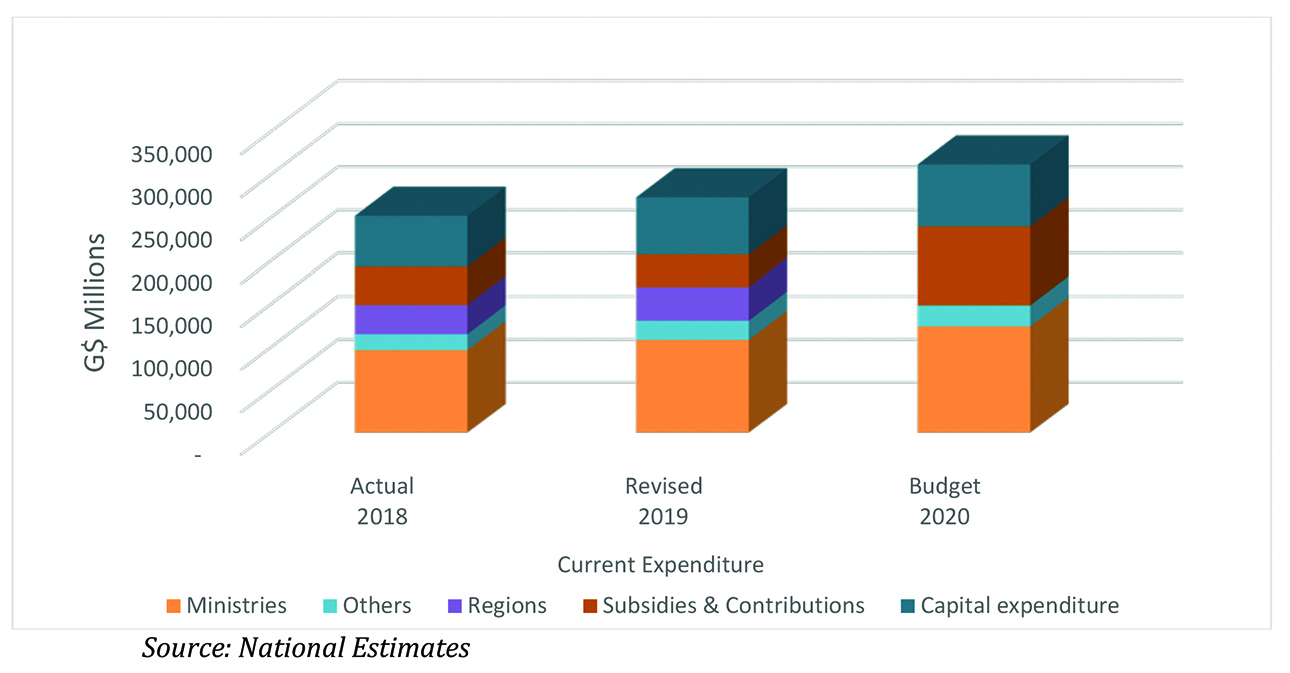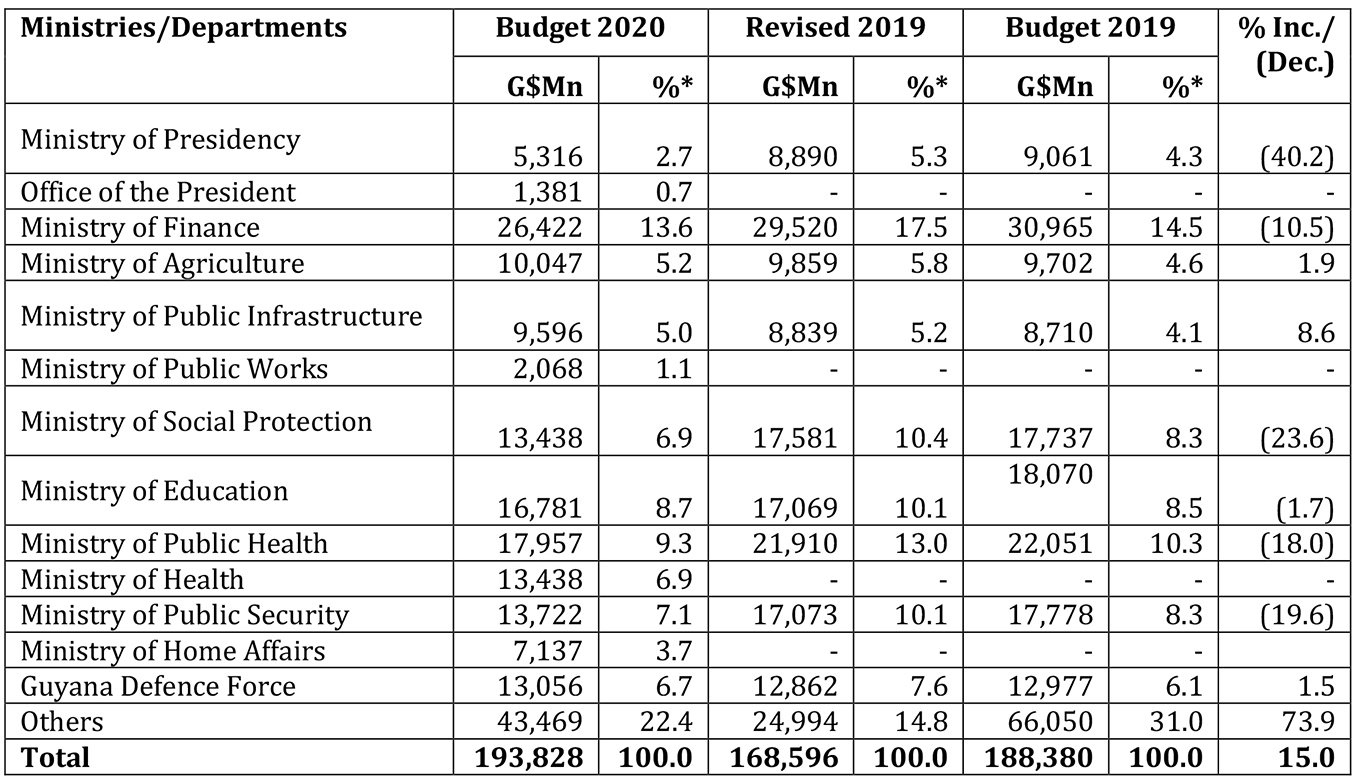Analysis of expenditure
Introduction
Under normal circumstances, the caption of this section would be by and large accurate. In this extra-ordinary year, with the Budget being essentially a four months projection on eight months of actual spending, the caption has to be considered misleading.
Properly executed, the Policies and Targets are reflected in the allocation of available funds via the various Ministries and other Budget Agencies. Most times execution is done directly, but at other times, via subventions and contributions to other entities. Expenditure in the National Budget is incurred under a number of categories. These are statutory payments which are direct charges on the Consolidated Fund, including allocations for constitutional bodies and offices and public debt payments of interest and principal; Ministries; Departments and Regions; and Statutory bodies.
Expenditure is further divided between Current Revenue and Current Expenditure, Interest, Capital Revenue and Grants, Capital Expenditure and Debt Repayment. In this section, we look at the allocations to the principal Budget Agencies largely by examining the details contained in Volume 1 of the National Estimates.
In this section, Focus looks at the current and capital expenditure by the type of agency. The chart above shows the allocations with “Others”, representing Commissions, the judiciary and the Defence Force.
Central Government’s non-interest current expenditure (employment costs, statutory expenditure and other charges) for the year is budgeted at $240 billion which is 15.6% more than the revised 2019. The Ministries/ Departments with the most significant allocations and the largest changes between 2019 and 2020 are:
* Percentage of total current non-interest expenditure
Source: Budget Estimates, Volume 1, Table 6.
Ram & McRae’s Comments
While the Ministry of Finance consistently ranks at or near the top, the expenditure is not all incurred within the Ministry. For 2020, it includes payments for GRA $6.6 billion (2019: $5,885) and Statistic Bureau $637 million (2019: $884 million); other subsidies and contributions to local organizations comprising mainly of $509 million (2019: $518 million); “other employment costs” which includes provisions for public service salary increases of $6.3 billion (2019: $6.2 billion) and pension increases of $3.8 billion (2019: $3.3 billion). The subvention of Guyana Security Council has increased from $110 million to 231 million in 2020 or by 1.1%.
There are 280 employees under the agency of which 107 are contract employees.
Significantly, in the year of a major pandemic, the Health sector accounts for over $31 billion of the current expenditure. Over the remaining three months of the year, the Ministry of Health is allocated $13.4 billion, under six programmes excluding Policy Development and Administration. Other charges make up $11.4 billion of this total while employment cost is a more modest $2 billion.
Current Expenditure for the Ministry of Education is spread among the four levels, i.e. nursery, Primary, Secondary and post-secondary education; Policy Development and Administration and training and development. Over 3,000 persons are employed in the Ministry with about 37% in the senior technical grade and a mere 3% being contracted employees.
The Ali Administration has reverted to the Ministry of Home Affairs (Agency 51) which captures three months of expenditure for the year 2020 while the Ministry of Public Security (Agency 54) captures nine months of expenditure for the year 2020. This switch in Ministries is identical to what took place in 2015 when the PPP/C ceded power to the Coalition. Agency 54 – Ministry of Public Security includes the Police Complaints Authority, the Prison Service, the Fire Service and CANU along with the Police Force.
This Ministry of Public Security employed 7,996 persons compared with 5,682 in 2015. Employment by the Ministry of Home Affairs by the new administration is projected at 8,140 which has increased by 1.8%. Average employment cost per person under the old Ministry of Public Security was $1.063 billion per month while as Ministry of Home Affairs the employment cost had projected to $1.4 billion.
In addition to Ministry Administration, Agency 21 -The Ministry of Agriculture is responsible for three programmes; Agriculture Development and Support Services, Fisheries, And Hydro Meteorological Services. Of the $10,046 million appropriated current expenditure $8,458 million was expended on contribution. $5.7 billion is allocated to the National Drainage and Irrigation Authority and $1.2 billion to NAREI, 84% of total appropriated current expenditure for the Ministry. The sole source of revenue of the National Drainage and Irrigation Authority is the Central Government. We are advised that there is no record in Parliament any financial statements have not been tabled for the NDIA.
Capital Expenditure
Central Government’s capital expenditure for the year is budgeted at $72 billion which is 10.5% above the revised 2019 and 21.9% of total 2019 expenditure.
Ram & McRae’s Comments
Vice President Jagdeo sought to explain the balance of the capital expenditure budget available to the new government and suggested that $22 billion was available beginning August 1, 2020.
The single largest expenditure under Agriculture and Support Services is the Capital contribution of $3 billion to GuySuCo. Usually for each capital expenditure there is Project Profile setting out, among other things, the description of the Project and its benefits. This omission ought to be rectified.
Some $1,445 million is being spent on institutional strengthening and upgrading of electrification systems. In fact, the total project cost is $17.63 million of which $8.199 million was spent prior to ‘2020’.
Guyana Power and Light also features under Contributions to Local Organisations involving a $10,782 million loan to the Corporation. Similar to the $300 Million to GuySuCo there is no further information to any of the estimates.
A provision of $1.2 million under Project Title “Low Carbon Development Programme” includes, among other things, Amerindian Land Titling and the institutional strengthening of the Department of Environment Office of Climate Change and Project Management Office.
In addition to the $5.7 billion of operating subsidy the NDIA is also being allocated a Capital Grant of $1,160 million for drainage and irrigation structures, not all of which are genuinely capital projects. Under Public Infrastructure there were two mega road projects. These were the miscellaneous roads project ($2,082 million) and the Highway improvement East Coast Demerara project ($2,599 million). The Ministry of Public Works is projecting to expend $1,320 million on sea and river defence works while the Ministry of Public Telecommunication had a provision of $3,130 million as a National Broadband project.
Under Local Government Development, some $460 million is provided as Capital Subvention for Municipalities and Neighbourhood Democratic Councils Profile of this allocation are quite limited.
Under the Ministry of Health Capital programme there is a provision of $2.9 billion for COVID response initiative. There is no capital project profile for this expenditure, the benefit of which is the reduced transmission of disease. The Georgetown Public Hospital Corporation is stated as receiving $7,446 million under the Ministry of Public Health and a $3,289 million under the Ministry of Health. Confusingly, there are two statements of revenue and expenditure for the Corporation.








